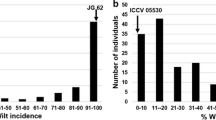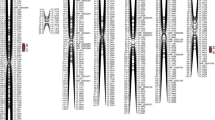Abstract
The main objective of the present study was to locate the genomic regions responsible for ascochyta blight resistance in faba bean. Six QTLs were identified with the help of a linkage map constructed from a F2 population from the cross between the inbred lines 29H (resistant) and VF136 (susceptible). Two pathogenically distinct Ascochyta isolates were used to study the genetic control against them and disease evaluations were performed separately on leaves and stems to investigate whether different genetic systems control resistance in each plant organ, as previously suggested. The six QTLs detected were named Af3 to Af8. Af3 and Af4 were effective against both Ascochyta isolates, Af5 was only effective against isolate CO99-01 while Af6, Af7 and Af8 were only effective against isolate LO98-01. Af3, Af4, Af5 and Af7 were revealed in both leaves and stems. By contrast, Af6 was only effective in leaves and Af8 only in stems. The validity and application of these results in a MAS program is discussed.


Similar content being viewed by others
References
Ali FH, Bernier CC (1985) Evaluation components of resistance to Ascochyta fabae in faba beans (Vicia faba). Phytopathology 75:962
Arahana VS, Graef GF, Specht JE, Steadman JR, Eskridge KM (2001) Identification of QTLs for resistance to Sclerotonia sclerotiorum in soybean. Crop Sci 41:180–188
Avila CM, Atienza SG, Moreno MT, Torres AM (2003a) Isozyme characterization of Vicia faba germplasm. Genetic interpretation and applications. Aust J Agric Res 54:409–421
Avila CM, Sillero JC, Rubiales D, Moreno MT, Torres AM (2003b) Identification of RAPD markers linked to the Uvf-1 gene conferring hypersensitive resistance against rust (Uromyces viciae-fabae) in Vicia faba L. Theor Appl Genet (in press)
Basten CJ, Weir BS, Zeng ZB (2001) QTL cartographer Version 1.15: a reference manual and tutorial for QTL mapping. North Carolina State University, Raleigh, North Carolina, USA
Bond DA, Pope M (1980) Ascochyta fabae on winter beans (Vicia faba) pathogen spread and variation in host resistance. Plant Pathol 29:59–65
Bond DA, Jellis GJ, Rowland GG, Le Guen J, Robertson LD, Khalil SA, Li-Juan L (1994) Present status and future strategy in breeding faba beans (Vicia faba L.) for resistance to biotic and abiotic stresses. Euphytica 73:151–166
Fall AL, Byrne PF, Jung G, Coyne DP, Brick MA, Schwartz HF (2002) Detection and mapping of a major locus for Fusarium wilt resistance in common bean. Crop Sci 41:1494–1498
Ford R, Pang ECK, Taylor PWJ (1999) Genetics of resistance to ascochyta blight (Ascochyta lentis) of lentil and the identification of closely linked RAPD markers. Theor Appl Genet 98:93–98
Gottlieb LD (1973) Enzyme differentiation and phylogeny in Clarkia franciscana, C. rubicunda and C. amoena. Evolution 27:205–214
Hanounik S (1980) Effect of chemical treatments and host genotypes on disease severity/yield relationships of ascochyta blight in faba beans. FABIS Newslett 2:50
Hanounik SB, Robertson LD (1989) Resistance in Vicia faba germplasm to blight caused by Ascochyta fabae. Plant Dis 73:202–205
Jellis GJ, Lockwood G, Aubury RG (1985) Phenotypic influences on the incidence of infection by Ascochyta fabae in spring varieties of faba beans (Vicia faba). Plant Pathol 34:347–352
Kharbanda PD, Bernier CC (1980) Cultural and pathogenic variability among isolates of Ascochyta fabae. Can J Plant Pathol 2:139–142
Kharrat M, Onfroy C, Tivoli B, Halila H (1997) Caractérisation morphologique et biologique des souches tunisiennes d’Ascochyta fabae, responsable de l’anthracnose des fèves. Les légumineuses alimentaires méditerranéennes. Rennes (France), 20–22 février. Ed INRA, Paris, France
Kim HS, Diers BW (2000) Inheritance of partial resistance to Sclerotinia stem rot in soybean. Crop Sci 40:55–61
Kohpina S, Knight R, Stoddard FL (1999) Variability of Ascochyta fabae in South Australia. Aust J Agric Res 50:1475–1481
Kohpina S, Knight R, Stoddard FL (2000) Genetics of resistance to Ascochyta blight in two populations of faba bean. Euphytica 112:101–107
Kosambi DD (1944) The estimation of map distance from recombination values. Ann Eugen 12:172–175
Li Z, Jakkula L, Hussey RS, Tamulonis JP, Boerma HR (2002) SSR mapping and confirmation of the QTLs from PI96354 conditioning soybean resistance to southern root-knot nematode. Theor Appl Genet 103:1167–1173
Lincoln SE, Daly MJ, Lander ES (1993) MAPMAKER/EXP version 3.0: a tutorial and reference manual, 3rd edn. Whitehead Institute for Biomedical Research, Cambridge, Massachusetts, USA
Macas J, Dolezel J, Lucretti S, Pich U, Meister A, Fuchs J, Schubert I (1993a) Localization of seed genes on flow-sorted field-bean chromosomes. Chrom Res 1:107–115
Macas J, Weschke W, Bäumleim H, Pich U, Houben A, Wobus U, Schubert I (1993b) Localization of vicilin genes via polymerase chain reaction on microisolated field-bean chromosomes. Plant J 3:883–886
Maurin N, Tivoli B (1992) Variation in the resistance of Vicia faba to Ascochyta fabae in relation to disease development in field trials. Plant Pathol 41:737–744
Melchinger AE (1990) Use of molecular markers in breeding for oligogenic disease resistance. Plant Breed 104:1-19
Michelmore RW (1995) Molecular approaches to manipulation of disease resistance genes. Annu Rev Phytopathol 15:393–427
Miklas PN, Johnson WC, Delorme R, Gepts P (2001) QTL conditioning physiological resistance and avoidance to white mold in dry bean. Crop Sci 41:309–315
Mohan M, Nair S, Bhagwat A, Krishna TG, Yano M, Bhatia CR, Sasaki T (1997) Genome mapping, molecular markers and marker-assisted selection in crop plants. Mol Breed 3:87–103
Muehlbauer FJ, Weeden NF, Hoffman DL (1989) Inheritance and linkage relationships of morphological and isozyme loci in lentil (Lens Miller). J Hered 80:298–303
Park SO, Coyne DP, Steadman JR, Skroch PW (2001) Mapping of QTL for resistance to white mold disease in common bean. Crop Sci 41:1253–1262
Pozarkova D, Koblizkova A, Roman B, Torres AM, Lucretti S, Lysak M, Dolezel J, Macas J (2002) Development and characterization of microsatellite markers from chromosome-1-specific DNA libraries of Vicia faba. Biol Plant 45:337–345
Pritchard PR, Rowe PS, Rossall S (1989) A comparison of infection of resistant and susceptible lines of field bean (Vicia faba) by Ascochyta fabae. Plant Pathol 48:266–270
Rashid KY, Bernier CC, Conner RL (1991a) Genetic of resistance in faba-bean inbred lines to five isolates of Ascochyta fabae. Can J Plant Pathol 13:218–225
Rashid KY, Bernier CC, Conner RL (1991b) Evaluation of faba bean for resistance to Ascochyta fabae and development of host differential for race identification. Plant Dis 75:852–855
Roman B, Torres AM, Rubiales D, Cubero JI, Satovic Z (2002) Mapping of quantitative trait loci controlling broomrape (Orobanche crenata Forsk.) resistance in faba bean (Vicia faba L.). Genome 45:1057–1063
Roman B, Satovic Z, Avila CM, Rubiales D, Moreno MT, Torres AM (2003) Locating genes associated with Ascochyta fabae resistance in Vicia faba L. Aust J Agric Res 54:85–90
Santra DK, Tekeoglu M, Ratnaparkhe ML, Kaiser WJ, Muehlbauer FJ (2000) Identification and mapping of QTLs conferring resistance to ascochyta blight in chickpea. Crop Sci 40:1606–1612
Schneider KA, Grafton KF, Kelly JD (2001) QTL analysis of resistance to fusarium root rot in bean. Crop Sci 41:535–542
Sillero JC, Avila CM, Moreno MT, Rubiales D (2001) Identification of resistance to Ascochyta fabae in Vicia faba germplasm. Plant Breed 120:529–531
Tivoli B, Reynaud B, Maurin N, Berthelem P, Le Guen J (1987) Comparison of some methods for evaluation of reaction of different faba bean genotypes to Ascochyta fabae. FABIS Newslett 17:35–38
Torres AM, Weeden NF, Martín A (1993) Linkage among isozyme, RFLP and RAPD markers in Vicia faba. Theor Appl Genet 85:937–945
Torres AM, Vaz Patto MC, Satovic Z, Cubero JI (1998) New isozyme loci in faba bean (Vicia faba L.): genetic analysis and mapping using trisomics. J Hered 89:271–274
Van Ooijen JW (1992) Accuracy of mapping quantitative trait loci in autogamous species. Theor Appl Genet 84:803–811
Van Ooijen JW (1999) LOD significance thresholds for QTL analysis in experimental populations of diploid species. Heredity 83:613–624
Vaz Patto MC, Torres AM, Koblizkova A, Macas J, Cubero JI (1999) Development of a genetic composite map of Vicia faba using F2 populations derived from trisomic plants. Theor Appl Genet 98:736–743
Welsh J, McClellan M (1990) Fingerprinting genomes using PCR with arbitrary primers. Nucleic Acids Res 18:7213–7218
Wendel JF, Weeden NF (1990) Visualization and interpretation of plant isozymes. In: Soltis DE, Soltis PS (eds) Isozymes in plant biology. Dioscorides Press, Portland, Oregon, USA, pp 5–45
Williams JGK, Kubelik AR, Livak KJ, Raflaski JA, Tingey SV (1990) DNA polymorphisms amplified by arbitrary primers are useful as genetic markers. Nucleic Acids Res 18:6531–6535
Yuan J, Njiti VN, Meksem K, Iqbal MJ, Triwitayakorn K, Kassem MA, Davis GT, Schmidt ME, Lightfoot DA (2002) Quantitative trait loci in two soybean recombinant inbred-line populations segregating for yield and disease resistance. Crop Sci 42:271–277
Acknowledgements
This study was supported by grants SC97-005-C2-1 and RTA01-30 from the Spanish Instituto Nacional de Investigaciones Agrarias (INIA). C.M. Avila was supported by a fellowship from INIA (Spain) and a fellowship from the Consejeria de Educacion y Ciencia (Junta de Andalucia) for a short stay in the Faculty of Agriculture of Zagreb (Croatia).
Author information
Authors and Affiliations
Corresponding author
Additional information
Communicated by H.F. Linskens
Rights and permissions
About this article
Cite this article
Avila, C.M., Satovic, Z., Sillero, J.C. et al. Isolate and organ-specific QTLs for ascochyta blight resistance in faba bean (Vicia faba L).. Theor Appl Genet 108, 1071–1078 (2004). https://doi.org/10.1007/s00122-003-1514-7
Received:
Accepted:
Published:
Issue Date:
DOI: https://doi.org/10.1007/s00122-003-1514-7




